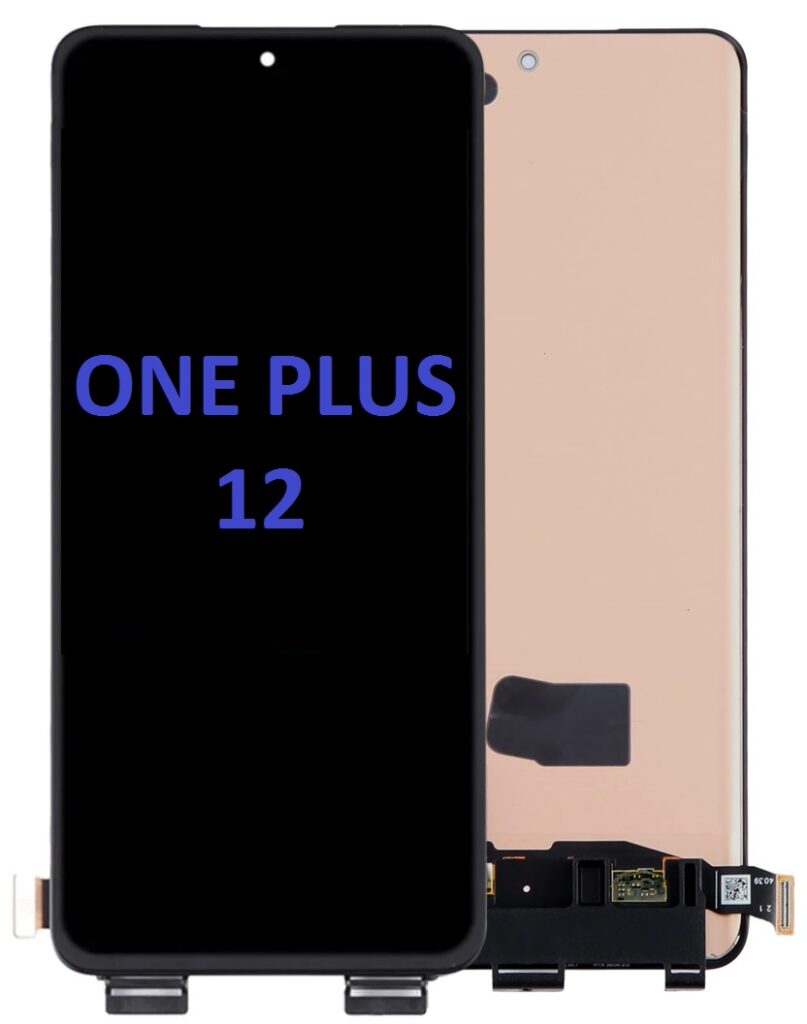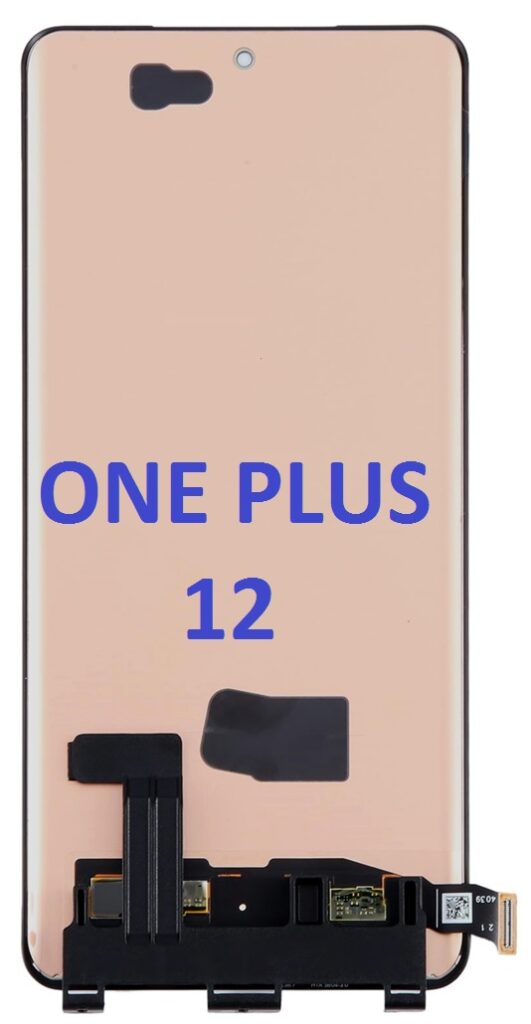
The OLED Assembly without Frame for OnePlus 12 is a critical component for those who need to replace or repair their device’s display, specifically when the frame or outer shell of the phone is intact. It includes only the OLED panel and its corresponding parts—display assembly, touch digitizer, and adhesive materials—without the additional structural frame that usually houses the screen. Below is an in-depth overview of this assembly and the process involved in working with it.
Overview of OLED Technology
OLED (Organic Light Emitting Diode) is a revolutionary display technology that has become widely adopted in high-end smartphones. Unlike traditional LCDs (Liquid Crystal Displays), OLED displays are self-emitting, meaning each individual pixel is capable of emitting light without the need for a backlight. This results in:
- Superior color accuracy and brightness compared to older LCD technologies.
- True black levels, as pixels can be individually turned off.
- Higher contrast ratios, which enhance the visual experience, especially in darker environments.
- Slimmer form factors, since no backlight is needed, allowing for thinner designs.
- Faster refresh rates, making it suitable for gaming and video content.
For the OnePlus 12, the OLED panel is custom-engineered to offer high resolution, vivid colors, deep blacks, and better energy efficiency, ensuring an enhanced display experience for users.
Components Included in the OLED Assembly
The OLED assembly without frame typically contains the following:

- OLED Display Panel: This is the main component of the assembly. It is a thin, flexible, and high-resolution display that handles both the visual output and touch input. For the OnePlus 12, the OLED panel will most likely have a high resolution, offering up to QHD+ or even 4K resolution, depending on the phone’s specifications.
- Touch Digitizer: The touch digitizer is the layer responsible for detecting the user’s touch inputs. This is integrated into the OLED panel itself, providing responsive touch interaction. The digitizer uses capacitive touch technology, which enables multi-touch functionality.
- Protective Glass (Top Layer): A thin, durable layer of glass protects the OLED display from external damage. It is often made from Gorilla Glass or similar toughened glass materials to ensure resilience against scratches, impacts, and other common forms of damage.
- Adhesive/Glue: A specific adhesive material is often included in the assembly to allow for a secure attachment between the OLED panel and the frame of the phone, or in this case, when you are replacing the screen without the frame, to ensure it sits properly during installation.
- Flex Cable/Connectors: The flex cables are responsible for connecting the OLED assembly to the phone’s motherboard, enabling communication between the display and the internal components. These are usually connected via ZIF (Zero Insertion Force) connectors or other types of connectors designed to simplify the installation process.
Benefits of OLED Displays for OnePlus 12
- Vibrant Colors and Deep Blacks: OLED displays allow each pixel to emit its own light, offering more vibrant colors and the ability to display true blacks. This creates a visually stunning experience for users when watching movies, playing games, or browsing content on the OnePlus 12.
- Power Efficiency: Since OLED screens only light up the pixels that are in use (in contrast to LCDs, which backlight the entire screen), they are more power-efficient. This helps conserve battery life, especially when displaying darker images or themes.
- Higher Refresh Rates: The OnePlus 12’s OLED assembly likely supports high refresh rates, such as 120Hz or more, for smoother transitions, animations, and responsiveness during interactions like scrolling, gaming, and video playback.
- Better Viewing Angles: OLED displays offer better viewing angles than traditional LCD screens, ensuring the display remains vibrant and clear even when viewed from an angle.
- Slimmer Design: OLED technology allows for thinner phone designs, as there is no need for bulky backlighting. This contributes to the OnePlus 12’s sleek and modern aesthetic.
Replacing the OLED Assembly Without Frame for OnePlus 12
Why Choose an OLED Assembly without Frame?
Choosing to replace just the OLED assembly without the frame is an excellent option when:
- The frame of the phone is not damaged. If the phone’s structural frame (the outer shell or chassis) is still intact and undamaged, it makes sense to replace only the display assembly. This reduces costs and time required for repairs.
- The phone is under warranty or the user wishes to avoid full-frame replacement. Some users prefer a non-invasive, more affordable repair option if the frame does not have significant damage.
- Customization: Some technicians or users may want to reuse the frame for other reasons, such as adding custom or aftermarket parts.
Tools and Process for Installation
- Preparation:
- Turn off the OnePlus 12 to ensure no electrical issues during the replacement.
- Prepare the necessary tools, which may include a heat gun or hairdryer, pry tools, suction cups, and a plastic pick for delicate handling.
- Removal of Old Display:
- If the phone already has a damaged OLED assembly, you’ll need to carefully heat the screen to soften the adhesive. Using a heat gun or hairdryer for a few minutes will loosen the adhesive.
- Once the adhesive has softened, use the suction cup to lift the screen slightly and insert a plastic pick around the edges to separate the OLED panel from the frame.
- Disconnect the flex cables carefully, ensuring that no damage occurs to the motherboard or connectors.
- Preparing the New OLED Assembly:
- If necessary, apply a thin layer of adhesive to the back of the new OLED display.
- Align the connectors and flex cables to the motherboard, ensuring that all parts are properly positioned.
- Installation:
- Gently press the new OLED assembly into place, ensuring that it is properly aligned with the phone’s frame.
- Reconnect the flex cables securely to the motherboard.
- Ensure that the display is working correctly before fully sealing it.
- Final Check:
- Power on the device to check for proper functionality. Test the touch responsiveness, brightness levels, and color accuracy.
- Once confirmed, press the screen firmly into place to ensure the adhesive bonds securely.
Considerations When Replacing OLED Assemblies
- Quality of the Part: It is crucial to source the OLED assembly from a reliable supplier to ensure that the part is of high quality. Low-quality screens can have color distortion, low brightness, and shorter lifespan.
- Warranty: Replacing the screen with an unauthorized part may void the warranty of the OnePlus 12. Always check with OnePlus or a certified repair center if you are concerned about maintaining warranty coverage.
- Risk of Damage: Repairing or replacing the OLED assembly without the right skills can result in further damage to the device. For those unfamiliar with phone repairs, seeking professional assistance is recommended to avoid costly errors.
- Calibration and Testing: After the replacement, it’s important to calibrate the display and perform testing to ensure that it works as expected. This includes checking for dead pixels, touch response, and the overall visual quality.
Conclusion
The OLED assembly without frame for OnePlus 12 is an essential replacement part for those who want to restore the functionality and visual quality of their device. It offers superior performance in terms of color accuracy, power efficiency, and display clarity. Whether you’re an experienced technician or a DIY enthusiast, replacing this assembly is a delicate yet rewarding task that ensures your OnePlus 12 retains its high-end screen performance.